Author: Parker Merritt Source: Coin Metrics Translation: Shan Ouba, Golden Finance
Key Points:
After the halving, Bitcoin's hash rate (30-day moving average) has fallen 7% from its all-time high of 626 EH/s to 580 EH/s currently
OKX's large-scale UTXO integration brought a brief boost to transaction fee revenue, with miners earning $38 million in transaction fees in 3 days
Toronto-based mining machine company Bitfarms has made impressive progress in mining machine efficiency, reducing incremental energy consumption from 35 J/TH to 50 J/TH by 2024
27 J/TH
At the height of the 2021 bull run, Antminer S19s traded for as much as $100/TH, but are now trading as low as $2.5/TH on secondary markets
Introduction
This week’s State of the Network report takes another look at the Bitcoin mining landscape, continuing our series of quarterly updates on the state of proof-of-work stakeholders. Since the Bitcoin halving in April, mining profits have been under pressure due to stagnant Bitcoin prices and a depressed fee market, although short periods of on-chain congestion have provided some relief to revenues. Many miners are diversifying beyond pure mining and repositioning themselves as general infrastructure providers in an attempt to secure hosting contracts for energy-intensive artificial intelligence applications. At the same time, chip efficiency gains continue unabated, forcing miners to consider whether to continue using older ASIC hardware or to make a full-scale mining machine upgrade. In this report, we will delve into each of these factors to assess the health of the mining industry in addition to Bitcoin price performance.
Mining Farm Consolidation
At first glance, the second quarter of 2024 was a relatively profitable period for Bitcoin miners. The quarter ranked fifth in total dollar revenue out of the 18 quarters since January 2020, with miners earning a total of $3.77 billion in revenue from block subsidies and transaction fees. Of course, these gains were front-loaded due to the halving, with April alone accounting for nearly half of the quarter's revenue. May and June have been tougher months for miners, with the Bitcoin block reward reduced from 6.25 BTC to 3.125 BTC on April 20, and the popularity of the “Rune” token fading in the following weeks. As a result, Bitcoin’s hashrate shows signs of miners withdrawing — the 30-day moving average of 580 EH/s is down 7% from the all-time high of 6.26 EH/s.
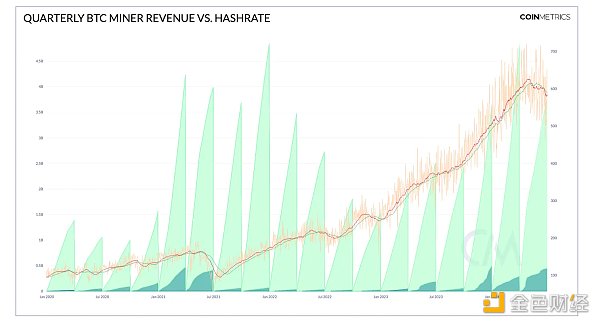
Source: Coin Metrics Network Data Pro
Although the overall revenue momentum has weakened, the unexpected increase in on-chain traffic has provided miners with some respite. In early June, the Bitcoin memory pool was crowded with a large number of transactions paying high transaction fees. By noon on June 7, the average hourly transaction fee was as high as $945. The congestion period has significantly boosted mining revenue, with the price of hashrate (dollar revenue per TH/s per day) soaring to $0.09, with fees contributing more than 42% of revenue.
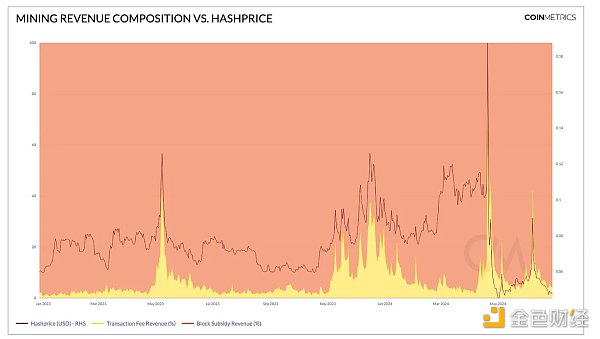
While fee surges are typically associated with token protocols like Ordinals and Runes, the recent mining revenue boost was driven by internal operations at a single centralized exchange. OKX (the fourth largest exchange by Bitcoin spot trading volume) conducted a series of large-scale "UTXO mergers" to clean up its books by combining fragmented Bitcoin shares into larger, more compact denominations. Since Bitcoin transaction fees depend on the block space they consume, transactions involving many UTXOs are more expensive to transfer, while "merged" UTXOs can unlock payments with a lighter, more cost-effective on-chain footprint.
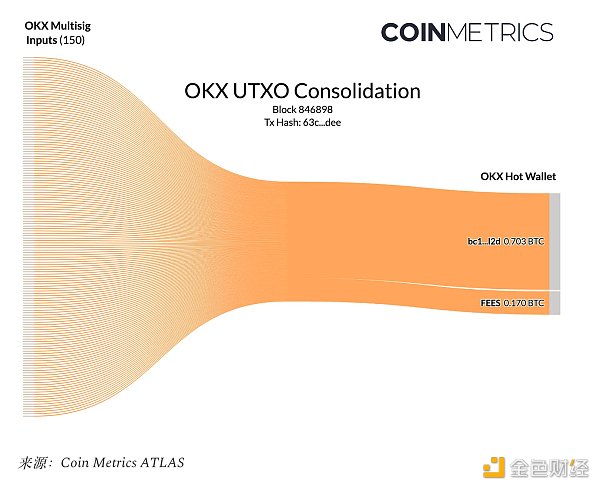
The UTXO merging process is similar to pouring a bunch of loose change into an automatic change machine and exchanging it for a $20 bill. However, like a change machine, this service also comes at a cost. While daily fee revenue is typically around $1-2 million, miners pocketed nearly $38 million in the 3 days following OKX’s UTXO merge. In hindsight, OKX could have performed their bookkeeping more efficiently, as they paid a hefty premium for fast settlements — but miners certainly aren’t complaining in the face of sluggish transaction queues and record-low hashrate prices.
The Importance of Infrastructure
Since the Bitcoin halving, the share prices of most publicly traded mining companies have moved sideways alongside Bitcoin. Share prices of the three largest mining companies — Marathon Digital (MARA), Clean Spark (CLSK), and Riot Platforms (RIOT) — all failed to outperform Bitcoin in the second quarter, with only Marathon managing to achieve a tiny relative return. Dark horse companies in the bitcoin mining race have fared the best so far, with Core Scientific (CORZ), Iris Energy (IREN), and TeraWulf (WULF) all outperforming their competitors by double digits. Coincidentally, these companies have all been heavily tapping into the AI boom, positioning themselves as providers of energy and infrastructure for a wider range of computing applications.
In June, Core Scientific signed a series of multibillion-dollar contracts with “AI supercomputing company” CoreWeave, agreeing to provide hundreds of megawatts of power capacity to host the company’s high-performance computing (HPC) hardware. Shortly after, CoreWeave submitted an “unsolicited proposal” to Core Scientific to acquire its entire business, but Core Scientific rejected the proposal, citing its “growth prospects” and “value creation potential.” IREN and WULF have also highlighted their unique positioning in hosting HPC infrastructure, which makes them attractive partners (and possible acquisition targets) for AI businesses that are increasingly facing energy constraints.
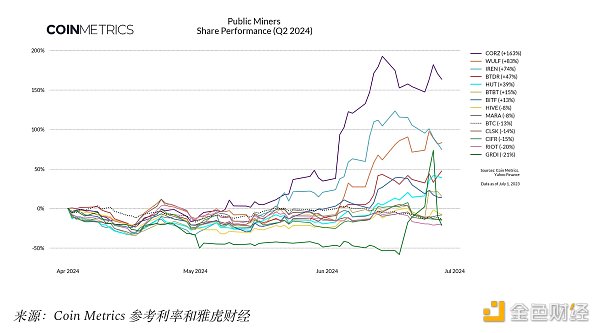
For other miners, share price movements are mainly driven by mergers and acquisitions within the industry. Although small-cap miner GRIID Infrastructure (GRDI) has lagged behind its peers since its listing this year, CleanSpark announced its acquisition of the company in June, claiming that the move would increase their power capacity by 400 megawatts within two years. In May, Riot Platforms disclosed its 9.25% stake in Bitfarms (BITF), a slightly smaller miner that is suffering from corporate governance issues. Riot has offered to buy all of Bitfarms for approximately $950 million, claiming that the acquisition would create the “world’s largest publicly traded Bitcoin mining company” by the end of the year. Bitfarms quickly rejected the offer, warding off Riot’s hostile takeover by issuing a “poison pill” program designed to dilute the shares of entities that seek to acquire it on the open market.
Riot’s motivation to acquire Bitfarms can be attributed to multiple factors, but one that is worth noting is their significant improvement in efficiency. Historically, Bitfarms has utilized low-cost hydroelectric power and adopted older generation ASIC chips rather than upgrading to cutting-edge hardware. This has caused them to lag behind competitors in metrics such as mining efficiency, which is measured in “joules per terahash” (J/TH), representing the incremental energy consumed to produce computing power. However, Bitfarms recently implemented a comprehensive mining machine refresh, purchasing 16 EH/s Antminer T21s (19 J/TH). In 2024, Bitfarms increased its average farm efficiency from 35 J/TH to 27 J/TH, surpassing Riot’s stagnant efficiency of 27.7 J/TH.
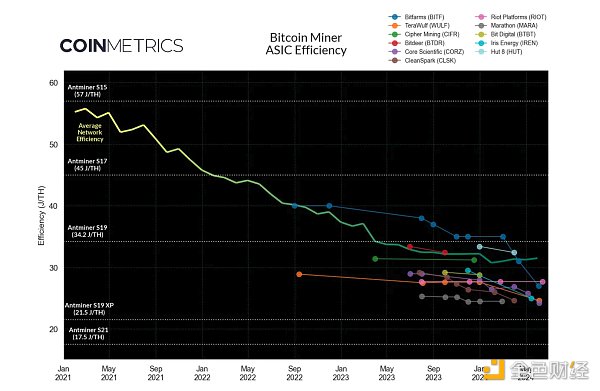
Bitfarms has made impressive progress in more than just improving average farm efficiency. Iris Energy has reduced its average energy consumption by 15% to 25 J/TH in the past 6 months, and TeraWulf has achieved an 11% efficiency improvement to 24.6 J/TH in the same period. Core Scientific, fresh out of Chapter 11 bankruptcy, currently leads with 24.23 J/TH, just ahead of current efficiency leader Marathon Digital at 24.5 J/TH. As the race to optimize operations narrows to decimal precision, miners are now looking to the next generation of ASIC chips to get ahead of the competition.
The ASIC Era
After more than a decade of chip manufacturing innovation, Bitcoin mining application-specific integrated circuits (ASICs) have achieved unprecedented improvements in efficiency. The first commercial ASIC chip, the Canaan Avalon 1, hit the market in January 2013 with a hashrate of just 0.06 TH/s. It consumed 620 watts, which equated to an efficiency of 10,333 J/TH. At the time, this was a big leap in raw hashrate output, with total network hashrate at just 22 TH/s. Soon after the Avalon 1 was released, rival manufacturers entered the market, and continued technological advances have resulted in a 14,000x increase in hashrate in two years.
Efficiency gains have tapered off from the early exponential growth period, but manufacturers are still working to reduce the energy required to produce a unit of hashrate. In June, Bitmain announced their latest Antminer S21 XP series, a water-cooled version that has a hashrate of 473 TH/s and an efficiency of 12 J/TH. While Bitmain remains the industry giant, upstarts like Bitdeer — led by former Bitmain CEO Jihan Wu — have announced ambitious plans to produce 5 J/TH ASIC chips by the second quarter of 2025.
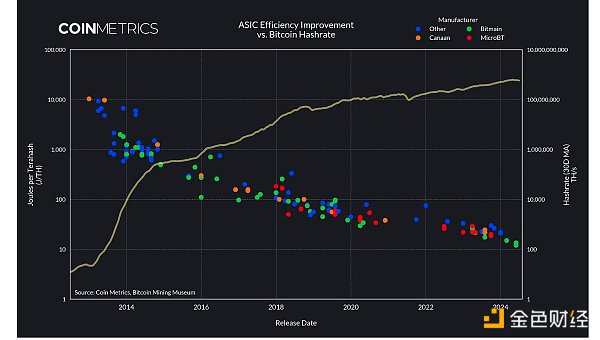
ASIC prices have plummeted as Bitcoin miners begin to phase out their existing hardware fleets in favor of more efficient models. While nominal prices vary by hardware specs, ASIC traders typically quote them in “dollars per terahash” ($/TH), providing an easily comparable metric for measuring the premiums of various models.
The 2021 bull run (coupled with China’s mining ban) has contributed to a period of excess profitability in BTC mining. This resulted in high premiums for Antminer S19 models (90-110 TH/s), with prices remaining high around $90-100/TH throughout the year. However, in 2022, plummeting revenues put significant pressure on ASIC premiums, with S19 prices falling by more than 80%. Post-halving, secondary markets such as Kaboomracks continue to capitulate, with the poorly performing S19 models trading as low as $2.5/TH in June. Despite losing the shine of the new generation, ASIC fingerprinting shows that the S19 series still contributes more than 50% of the hashrate, suggesting that they are being redeployed to lower-cost sites rather than being retired entirely. Even the 2016 Antminer S9 maintains a place at the edge of the grid, still reliably turning waste energy into electronic cash nearly a decade after its debut. While the most efficient operators will undoubtedly choose to replace their miners with the latest models, the rugged and highly industrialized form factor of modern Bitcoin mining ASICs ensures that almost every machine will eventually find a place in the proof-of-work ecosystem.
Conclusion
Bitcoin’s fifth era is likely to be characterized by consolidation, with deep-pocketed miners acquiring the assets of less efficient operators. The AI industry also envies the industry’s unique energy infrastructure, and many publicly traded miners have successfully adopted more general data center strategies. Others remain focused on Bitcoin, viewing HPC juggling as a temporary distraction. Regardless, to survive the onslaught of efficiency gains and competitive pressures, all miners must look to the future, and the long-term trajectory of BTC prices remains an unpredictable input to a highly capital-intensive business model.
Network Data Insights
Summary Indicators
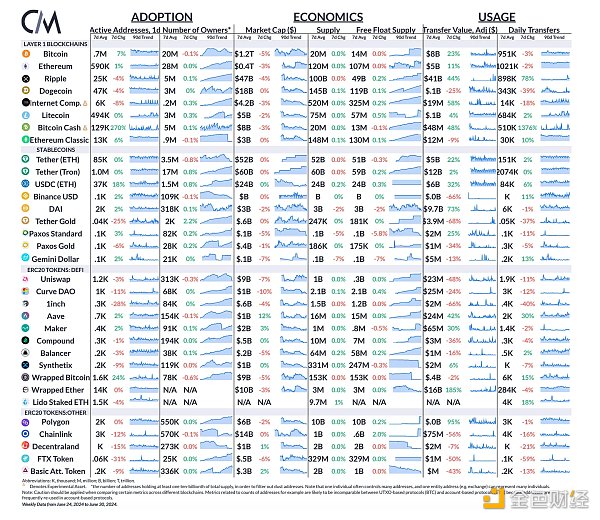
 JinseFinance
JinseFinance
 JinseFinance
JinseFinance JinseFinance
JinseFinance JinseFinance
JinseFinance Sanya
Sanya JinseFinance
JinseFinance Huang Bo
Huang Bo JinseFinance
JinseFinance Cheng Yuan
Cheng Yuan Cheng Yuan
Cheng Yuan Ftftx
Ftftx